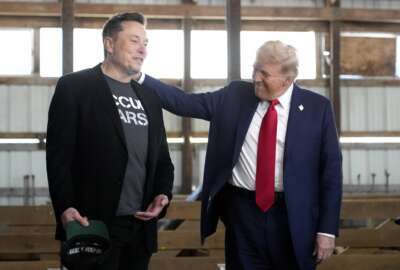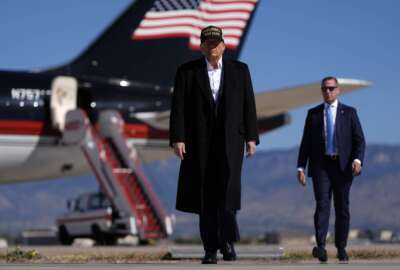House GOP setting up DOGE subcommittee to address ‘wasteful’ federal spending
A source familiar with the Oversight committee’s plans said lawmakers have already met with key members of the incoming Trump administration’s DOGE team.
Worried about Schedule F and the future of your job? Excited to see if DOGE can improve government efficiency? Want to know more about the proposed pick to head up your department? Federal News Network is tracking all things transition-related, as the 47th administration’s plans for the federal workforce take shape. Visit our Tracking the Transition page to keep up with the latest developments.
The Department of Government Efficiency’s efforts to make massive cuts to the federal workforce and government spending will soon come under Congress’ microscope as well.
Leaders on the House Oversight and Accountability Committee announced plans this week to form a DOGE subcommittee in the next Congress. Rep. Marjorie Taylor Greene (R-Ga.) will serve as the subcommittee’s chairwoman.
DOGE, led by Elon Musk and former GOP presidential candidate Vivek Ramaswamy, aims to cut $2 trillion in government spending — a number well above several attempts from previous administrations to improve government efficiency. President-elect Donald Trump tapped Musk and Ramaswamy to lead the external commission.
A source familiar with the Oversight committee’s plans said lawmakers have already met with the incoming Trump administration’s DOGE team, including Ramaswamy. The source added that the DOGE team is “supportive” of the committee’s plans and the two groups are already working together.
“The DOGE subcommittee will support the Oversight and Accountability Committee’s mission to root out waste, fraud and abuse in the federal government,” the source told Federal News Network. “Its objectives include investigating wasteful spending, examining ways to reorganize federal agencies to improve efficiency and identifying solutions to eliminate bureaucratic red tape.”
Oversight Committee Ranking Member Jamie Raskin (D-Md.), however, criticized the GOP-led committee’s plans for the new subcommittee.
Greene “will chair a subcommittee to work with two unvetted billionaires who stand to receive billions more in government contracts and subsidies from the government under Trump,” Raskin said. “That’s why Democrats will stay focused on waste, fraud, abuse and corruption. The government belongs to the people, not the billionaire oligarchs.”
Committee Chairman James Comer (R-Ky.) is expected to remain the committee’s leader in the next Congress. In the coming weeks, Comer plans to announce additional Oversight subcommittees, which will be officially established early next year once the 119th Congress begins.
DOGE leaders propose ‘large-scale firings’ of feds
Many of the specifics for how DOGE would attempt to accomplish its goals are still unclear, but more details are beginning to emerge. In a Nov. 20 op-ed published by the Wall Street Journal, Musk and Ramaswamy said Trump could use executive action to drastically reduce the size of the federal workforce including by implementing “reductions in force,” conducting “large-scale firings” and relocating agency headquarters outside of Washington, D.C.
“We will focus particularly on driving change through executive action based on existing legislation rather than by passing new laws,” they wrote.
At least some of DOGE’s recommendations could be implemented through the Office of Personnel Management, General Services Administration and the Office of Management and Budget.
“There can be quite a bit done, given the existing rules, without even changing any law, rule or regulation,” Kevin Owen, a partner at Gilbert Employment Law, which specializes in federal employment law, said in an interview. “But there are things that can be done to make the federal government not just an unattractive employer, but a bad employer, that would make people just objectively not want to work for the government.”
At the same time, former Virginia Republican Congressman Tom Davis said implementing any major workforce cuts or scaling back funding at the levels DOGE has suggested would be highly challenging — and some of it would require legislative approval.
“Legislation is tremendously hard. You have to be able to fit it within reconciliation, and they may overreach in some of these areas,” Davis said Wednesday at a Coalition for Government Procurement conference. “The best thing I can say is, you dialog and you figure out who you can talk to about this, and make sure that whatever they want to do, they don’t do it stupidly.”
Elaine Kamarck, a senior fellow at the nonprofit Brookings Institution, called the approach the DOGE team has so far taken “unrealistic.” In a Nov. 18 op-ed for Brookings, Kamarck argued that deep cuts to the federal workforce and to the government’s discretionary budget would make it difficult if not impossible for agencies such as the Social Security Administration, Federal Aviation Administration and Customs and Border Protection to carry out their missions.
“So how do you cut government? With a scalpel, not an axe,” Kamarck wrote. She added that during the Clinton administration, “we conducted a thorough review agency by agency, something the DOGE program would be wise to repeat.”
On the campaign trail, Trump also made promises to relocate more than 100,000 employees, as well as revive a Schedule F-type policy to remove certain federal employees’ civil service protections and make them easier to remove from their jobs.
Proponents of Schedule F said the efforts are meant to give agencies more flexibility and give them the ability to fire employees who are performing poorly in their jobs. But critics of Schedule F have called the executive order a thinly veiled attempt to politicize the career civil service.
Everett Kelley, national president of the American Federation of Government Employees — the largest union representing federal employees — urged the incoming administration to conduct a much deeper analysis of the federal workforce.
“To call federal employees ‘bureaucrats,’ to call federal employees ‘deep state,’ in my opinion, is an indictment against federal employees,” Kelley said Friday morning in an interview on C-SPAN. “The federal employees that you’re calling bureaucrats are the nurses that take care of the veterans who are wounded. They are Social Security workers. They are [Bureau of Prisons] employees. They are [Transportation Security Administration] workers that make sure that our skies are safe. They are the meat inspectors who make sure that the food we eat is safe. To say you’re going to cut them, without first of all analyzing and seeing what the federal government really needs, I think, is misguided.”
“The government should never be based on whether or not I’m loyal to you as an individual,” Kelley added. “It should be based on whether or not I have the expertise to do the job that I’m hired to do.”
Another workforce reduction strategy Musk and Ramaswamy highlighted in their op-ed was removing number of career federal employees that’s proportional to the number of federal regulations that are “nullified.”
“Not only are fewer employees required to enforce fewer regulations, but the agency would produce fewer regulations once its scope of authority is properly limited,” Musk and Ramaswamy wrote.
The basic rationale is that less need for regulatory oversight means less need for people to conduct that oversight, Owen explained. But he said implementation of the idea the op-ed described wouldn’t be feasible, given the plan’s scale and scope — and that the largest federal employers are agencies like the Defense Department, the Department of Veterans Affairs and the Postal Service.
“All of those positions have nothing to do with regulatory oversight. Those are government services. Reducing the number of regulations isn’t going to correlate into actual job loss,” Owen said.
And in general, Owen said, many of DOGE’s ideas are easier said than done, particularly with the July 4, 2026, deadline that Musk and Ramaswamy presented for achieving the organization’s goals.
“There are rules and there are [reduction in force] rights, so there will be protections, especially for those who have been high performers, those with veteran status, those who have significant years of service,” Owen said. “Whether or not there’s going to be a wholesale stop to it, whether there can be court litigation over getting some sort of restraining order — it’s yet to be seen on the particulars.”
Owen, however, added that he sees the plans of a DOGE subcommittee as more of a positive development.
“Anytime you’ve seen major adjustments in the civil service regulations and rules, there has been robust congressional interest and on-the-record conversations about the scope, purposes and intent,” Owen said. “There would be that level of public discourse out there for the people to see why things are being changed.”
The Partnership for Public Service said it’s generally supportive of more efficient and effective government, but the nonprofit good government organization cautioned against pursuing initiatives before pursuing a greater analysis and understanding of the federal workforce.
“There are many ways that we can make these services more efficient — from implementing outstanding recommendations from federal oversight entities, to investing in needed changes to personnel capacity and outdated IT systems, to building on policy recommendations,” the Partnership said in a statement to Federal News Network. “To be effective, any efficiency initiative, including DOGE, must begin with a deep understanding of the work that agencies do, who the agencies’ customers are and ensure that proposed changes will not negatively impact service and mission delivery. We should all support ways to make the federal government work better, however, arbitrary cuts to personnel and programs will not achieve that outcome.”
Regardless, former Congressman Davis said he expects DOGE to be “front and center” for offering Trump recommendations on significantly cutting down employees and costs in the federal government.
“Out of all this chaos are some opportunities as well,” Davis said. “We have some clues in terms of where they may go to deliver services more efficiently, more cost effectively. They recognize that there are some things in Washington that have gone on for a long time that just aren’t really working very well. We’ve gone away from mission-driven government, basically to regulation-driven government, and you’re not getting the innovation that you need.”
Wave of federal exits would be “welcome,” DOGE team says
In the years following the COVID-19 pandemic, telework for federal employees has remained a large point of contention. In April 2023, the Biden administration asked agencies to bring telework-eligible federal employees onsite for about 50% of their work hours. Since then, many agencies have implemented return-to-office changes to place employees around that level of in-person work.
In August, OMB reported that out of 2.2 million federal employees, about 54% of federal employees work fully in person, 46% of feds are eligible for telework and 10% work fully remotely. Governmentwide, telework-eligible federal employees are currently performing about 61% of their work hours onsite.
Many Republicans, however, have criticized the government’s telework policy and placed increasing pressure on the Biden administration to fully return federal employees to onsite work. They have blamed telework as the reason behind agency backlogs and customer service challenges. A 2023 GOP-led bill titled the “SHOW UP” Act aims to return agencies to their pre-pandemic levels of telework.
In their op-ed, Musk and Ramaswamy said they would “welcome” what they expect would be a “wave” of federal employees leaving their jobs if the incoming Trump administration sets a requirement for all feds to work in person five days a week.
In several agency case studies, telework options were shown to improve federal recruitment and retention — but pay and workload were still more important factors for successful federal hiring, the Government Accountability Office found in a Nov. 22 report.
GAO’s report also found that factors other than telework, such as workloads, staffing levels and technology, are better predictors of agency performance. In one example, IRS officials said staffing increases and technology upgrades that stemmed from the 2022 Inflation Reduction Act contributed to the agency’s improvements in customer service and call wait times for taxpayers.
At the same time, GAO said agencies still need to fully evaluate how telework impacts agency performance outcomes. Some agencies have said the complexity of understanding how telework affects performance makes it difficult to reach a solid answer.
Copyright © 2025 Federal News Network. All rights reserved. This website is not intended for users located within the European Economic Area.
Drew Friedman is a workforce, pay and benefits reporter for Federal News Network.
Follow @dfriedmanWFED






